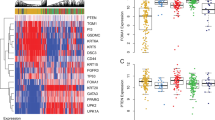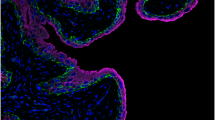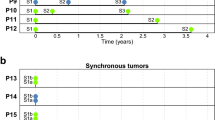Abstract
Bladder carcinogenesis remains unclear despite the identification of chemical, environmental and genetic factors. It has recently been reported that the chromosomal region 12q13–q15, containing crucial cancer genes such as MDM2, CDK4 and GLI, is amplified in bladder cancer. In the same region are also located the genes of the locus HOX C, flanked by keratin genes whose protein product may be a prognostic marker of bladder cancer. The HOX genes constitute a network of transcription factors controlling embryonal development and play an important role in crucial adult eukaryotic cell functions. The molecular organization of this 39-gene network is unique in the genome and probably acts by regulating phenotypical cell identity. We have analysed the expression of the whole HOX gene network in pairs of normal–tumour bladder and in tumoral biopsies. Comparison between normal urothelium and bladder tumour has identified dramatic variations of expression in a block of three genes (HOX C4, HOX C5 and HOX C6) localized in the HOX C locus on the chromosome 12q13 and in the paralogous group 11 HOX genes, involved during normal development in the formation of the urogenital system. These data suggest a key involvement of the HOX gene network, and especially the locus C, in bladder cancer.
This is a preview of subscription content, access via your institution
Access options
Subscribe to this journal
Receive 50 print issues and online access
$259.00 per year
only $5.18 per issue
Buy this article
- Purchase on Springer Link
- Instant access to full article PDF
Prices may be subject to local taxes which are calculated during checkout


Similar content being viewed by others
References
Abate-Shen C . (2002). Nat. Rev. Cancer, 2, 777–785.
Adshead JM, Ogden CW, Penny MA, Stuart ET and Kessling AM . (1999). BJU Int., 83, 1039–1044.
Akam M . (1987). Development, 101, 1–22.
Apiou F, Flagiello D, Cillo C, Malfoy B, Poupon MF and Dutrillaux B . (1996). Cytogenet. Cell Genet., 73, 114–115.
Cantile M, Pettinato G, Procino A, Feliciello I, Cindolo L and Cillo C . (2003a). Eur. J. Cancer, 39, 257–264.
Cantile M, Procino A, D'Armiento M, Cindolo L and Cillo C . (2003b). J. Cell. Physiol., 194, 225–236.
Chirgwin JM, Przybyla AE, MacDonald RJ and Rutter WJ . (1979). Biochemistry, 18, 5294–5299.
Christoph F, Schmidt B, Schmitz-Drager BJ and Schulz WA . (1999). Int. J. Cancer, 84, 169–173.
Cillo C . (1994–95). Invas. Metastasis, 14, 38–49.
Cillo C, Barba P, Freschi G, Bucciarelli G, Magli MC and Boncinelli E . (1992). Int. J. Cancer, 51, 892–897.
Cillo C, Cantile M, Faiella A and Boncinelli E . (2001). J. Cell. Physiol., 188, 161–169.
Cillo C, Cantile M, Mortarini R, Barba P, Parmiani G and Anichini A . (1996). Int. J. Cancer, 66, 692–697.
Cillo C, Cantile M, Mortarini R, Tiberio C, Barba P, Anichini A and Poupon MF . (1995a). Proceedings 86° AACR-abs. 3358.
Cillo C, Wilmore HP, Barba P and Brown KW . (1995b). Int. J. Oncol., 7, 1145–1150.
Cordon-Cardo C . (1998). Cancer Surv., 32, 115–131.
Davis AP and Capecchi MR . (1994). Development, 120, 2187–2198.
Davis AP, Witte DP, Hsieh-Li HM, Potter S and Capecchi M . (1995). Nature, 375, 791–795.
Dekker EJ, Pannese M, Houtzager E, Timmermans A, Boncinelli E and Durston A . (1992). Development (Suppl.) 195–202.
Duboule D and Morata G . (1994). Trends Genet., 10, 358–364.
Favier B, Le Meur M, Chambon P and Dollé P . (1994). Proc. Natl. Acad. Sci. USA, 92, 310–314.
Ferber S, Halkin A, Cohen H, Ber I, Einav Y, Goldberg I, Barshack I, Seijffers R, Kopolovic J, Kaiser N and Karasik A . (2000). Nat. Med., 6, 568–572.
Fujimoto K, Yamada Y, Okajima E, Kakizoe T, Sasaki H, Sugimura T and Terada M . (1992). Cancer Res., 52, 1393–1398.
Gazzaniga P, Gradilone A, Frati L and Agliano AM . (2001). Clin. Cancer Res., 7, 4288–4289.
Gehring WJ and Hiromi Y . (1986). Annu. Rev. Genet., 20, 147–173.
Graham A, Papalopulu N and Krumlauf R . (1989). Cell, 57, 367–378.
Gromova I, Gromov P and Celis JE . (1999). Electrophoresis, 20, 241–248.
Hostikka SL and Capecchi MR . (1998). Mech. Dev., 70, 133–145.
Hu G, Lee H, Price SM, Shen MM and Abate-Shen C . (2001). Development, 12, 2373–2384.
Jave-Suarez LF, Winter H, Langbein L, Rogers MA and Schweizer J . (2002). J. Biol. Chem., 277, 3718–3726.
Jones SN, Sands AT, Hancock AR, Vogel H, Donehower LA, Linke SP, Wahl GM and Bradley A . (1996). Proc. Natl. Acad. Sci. USA, 93, 14106–14111.
Kinzler KW, Bigner SH, Bigner DD, Trent JM, Law ML, O'Brien SJ, Wong AJ and Vogelstein B . (1987). Science, 236, 70–73.
Lander ES . et al. (2001). Nature, 409, 860–921.
Lussier M, Filion M, Compton JG, Nadeau JH, Lapointe L and Royal A . (1990). Gene, 95, 203–213.
Magli, MC, Barba P, Celetti A, De Vita G, Cillo C and Boncinelli E . (1991). Proc. Natl. Acad. Sci. USA, 88, 6348–6352.
Moll R, Achtstatter T, Becht E, Balcarova-Stander J, Ittensohn M and Franke WW . (1988). Am. J. Pathol., 132, 123–144.
Moll R, Franke WW, Schiller DL, Geiger B and Krepler R . (1982). Cell, 31, 11–24.
Mortlock DP and Innis JW . (1997). Nat. Genet., 15, 179–180.
Nakamura T, Largaespada DA, Lee MP, Johnson LA, Ohyashiki K, Toyama K, Chen SJ, Willman CL, Chen IM, Feinberg AP, Jenkins NA, Copeland NG and Shaughnessy Jr JD . (1996). Nat. Genet., 12, 154–158.
Nilsson M, Unden AB, Krause D, Malmqwist U, Raza K, Zaphiropoulos PG and Toftgard R . (2000). Proc. Natl. Acad. Sci. USA, 97, 3438–3443.
Nocito A, Konenen J, Kallioniemi OP and Sauter G . (2001). Int. J. Cancer, 94, 1–5.
Raman V, Martensen SA, Reisman D, Evron E, Odenwald WF, Jaffee E, Marks J and Sukumar S . (2000). Nature, 405, 974–978.
Reed SI . (1997). Cancer Surv., 29, 7–23.
Sandberg AA . (2002). Am. J. Med. Genet., 115, 173–182.
Scott MP . (1992). Cell, 71, 551–553.
Shinohara N and Koyanagi T . (2002). Urol. Res., 30, 273–281.
Simeone A, Pannese M, Acampora D, D'Esposito M and Boncinelli E . (1988). Nucleic Acids Res., 16, 5379–5390.
Simon R, Richter J, Wagner U, Fijan A, Bruderer J, Schmid U, Ackermann D, Maurer R, Alund G, Knonagel H, Rist M, Wilber K, Anabitarte M, Hering F, Hardmeier T, Schonenberger A, Flury R, Jager P, Fehr JL, Mihatsch MJ, Gasser T and Sauter G . (2001). Cancer Res., 61, 4514–4519.
Simon R, Struckmann K, Schraml P, Wagner U, Forster T, Moch H, Fijan A, Bruderer J, Wilber K, Mihatsch MJ, Gasser T and Sauter G . (2002). Oncogene, 21, 2476–2483.
Spitz F, Gonzales F and Duboule D . (2003). Cell, 113, 405–418.
Small KM and Potter SS . (1993). Genes Dev., 7, 2318–2328.
Wada T, Louhelainen J, Hemminki K, Adolfsson J, Wijkstrom H, Norming U, Borgstrom E, Hansson J, Sandstedt B and Steineck G . (2000). Clin. Cancer Res., 6, 610–615.
Walterhouse D, Ahmed M, Slusarski D, Kalamaras J, Boucher D, Holmgren R and Iannaccone P . (1993). Dev. Dyn., 196, 91–102.
Wolfel T, Hauer M, Schneider J, Serrano M, Wolfel C, Klehmann-Hieb E, De Plaen E, Hankeln T, Meyer zum Buschenfelde KH and Beach D . (1995). Science, 269, 1281–1284.
UICC (1997). TNM Classificationof Malignant Tumors, 5th edn. Wiley-Liss: New York.
Yoon SJ, LeBlanc-Straceski J, Ward D, Krauter K and Kucherlapati R . (1994). Genomics, 24, 502–508.
Acknowledgements
We thank L Terracciano for his critical reading of the manuscript and A. Procino for the helpful participation in this project. CC acknowledges the financial support of MURST 2001 projects.
Author information
Authors and Affiliations
Corresponding author
Rights and permissions
About this article
Cite this article
Cantile, M., Cindolo, L., Napodano, G. et al. Hyperexpression of locus C genes in the HOX network is strongly associated in vivo with human bladder transitional cell carcinomas. Oncogene 22, 6462–6468 (2003). https://doi.org/10.1038/sj.onc.1206808
Received:
Revised:
Accepted:
Published:
Issue Date:
DOI: https://doi.org/10.1038/sj.onc.1206808
Keywords
This article is cited by
-
A transcriptional network of cell cycle dysregulation in noninvasive papillary urothelial carcinoma
Scientific Reports (2022)
-
HOXC10 upregulation confers resistance to chemoradiotherapy in ESCC tumor cells and predicts poor prognosis
Oncogene (2020)
-
HOX gene cluster (de)regulation in brain: from neurodevelopment to malignant glial tumours
Cellular and Molecular Life Sciences (2020)
-
The long noncoding RNA HOTAIR has tissue and cell type-dependent effects on HOX gene expression and phenotype of urothelial cancer cells
Molecular Cancer (2015)
-
HOXB9 promotes epithelial-to-mesenchymal transition via transforming growth factor-β1 pathway in hepatocellular carcinoma cells
Clinical and Experimental Medicine (2015)



